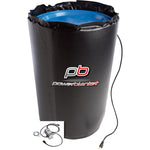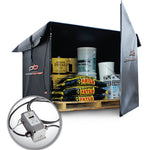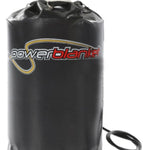You have no items in your shopping cart.
Inline Heaters: How to Choose the Right One for Your Application
Article At-a-Glance
What is an Inline Heater and How Do You Choose the Right One?
An inline heater is a device inserted into a pipeline or tank to heat fluids or gases quickly and maintain a constant temperature, and choosing the right one involves considering factors like the type of fluid, flow rate, temperature range, and space requirements to ensure optimal performance for your specific application.
Key Takeaways
- Understand the Applications: Inline heaters are versatile devices used in various industries, including chemical processing, food and beverage production, oil and gas, water heating systems, and medical applications, to quickly heat fluids or gases and maintain consistent temperatures.
- Key Selection Criteria: When choosing an inline heater, consider factors such as the type of fluid or gas, flow rate, temperature range, space and power requirements, and necessary safety features to ensure optimal performance and safety.
- Installation and Safety: Proper installation by a professional is crucial to prevent damage and ensure safe operation. Follow manufacturer guidelines for installation, wiring, and system testing to maintain system integrity.
- Types of Inline Heaters: Explore different types of inline heaters, such as immersion, circulation, flanged, screw plug, over-the-side, infrared, and electric coil heaters, to find the best fit for your specific application needs.
-
Alternative Solutions: In some scenarios, alternative heating methods like preheated fluids, heated tanks, or heat exchangers may be more suitable, especially in challenging environments where additional heating support is required.
Selecting the right inline heater for your specific piping situation doesn’t have to be difficult. Knowing the size of your pipe and the operating temperature range of your fluids or gasses are key to choosing the right heater. Read on to learn what you need to know about inline heaters.

$780.00 USD
4" to 5" Diameter x 5' Long Xtreme Pipe Wrap Heater (120V)
For reliable freeze protection and efficient heating, consider using pipe heaters. These heaters maintain consistent temperatures in your pipeline, preventing costly freezes and keeping your fluids flowing smoothly.
What is an inline heater, and what are its applications?
An inline heater (sometimes known as a circulation heater or liquid heater) is a device inserted into a pipeline or tank that is used to heat the fluid or gas contained within. Inline heaters are often used in applications where it is necessary to heat the fluid quickly or to maintain a constant temperature, such as:
- Chemical processing: Inline heaters can be used to heat chemicals in various manufacturing processes, including polymerization, fermentation, and distillation.
- Food and beverage production: Inline heaters are commonly used to heat and sterilize liquids such as milk, beer, and juice.
- Oil and gas processing: Inline heaters are used in oil and gas processing to maintain the temperature of crude oil or natural gas. They are also used to prevent the formation of waxes or hydrates in pipelines.
- Water heating systems: Inline heaters are often utilized in water heating systems, such as boilers and totes, to maintain a desired temperature. They can also be used to protect your tote from freezing in both indoor and outdoor environments.
- Medical and pharmaceutical applications: Inline heaters can be used in medical and pharmaceutical applications to heat fluids used in drug manufacturing, laboratory testing, and medical treatment.
Several of the above-mentioned industries rely on inline heating elements that are built to be used within pipes. These heating elements must be able to function within pipelines that contain many different materials, including gasses and liquids that are corrosive. Thankfully, inline heaters can be very reliable in these situations if they are built by a trusted manufacturer that adheres to industry standards.
How to choose the right inline heater for your needs
Inline heaters are built for a wide range of heating environments. Choosing the right inline heater means understanding what you intend to use it for, how much space there is to use the inline heater, and other factors. Here are some of the most important things to keep in mind:
- Type of fluid or gas: The type of material that will be flowing through the heater can affect the material and design of the heater.
- Flow rate and pressure: The required flow rate and pressure of the system should be considered to ensure that the heater can provide sufficient heating capacity and maintain the desired temperature.
- Temperature range: Different heaters have different temperature ranges. Choose a heater that can handle the precise temperature range required for your specific application.
- Size and space requirements: Ensure that the inline heater can fit within available space and connect to your existing piping system.
- Power requirements: Some inline heaters require electrical power to operate. Make sure that your on-site electrical supply can meet the power requirements of the heater.
- Safety features: Overheat protection, pressure relief valves, safety cutouts, and other critical safety features should be looked at when selecting an inline heater. Get an industrial heater for hazardous areas that increases workplace safety.
- Manufacturer's reputation: Choose a heater from a reputable manufacturer with a proven track record of producing high-quality, reliable products.
Once you feel you’ve found the right inline heater for your process heating system, look to see if it comes with any helpful resources, such as warranties, installation assistance, or post-purchase customer service.
How to install and use an inline heater safely
The installation process for an inline heater can vary depending on the specific type and model of the heater, as well as the particular system it will be used in. Different types of inline heaters will have their own unique way of installing them into your process heating system.

Below are some general steps for installing an inline heater:
- Choose the location for the heater in the pipeline or tank, keeping in mind factors such as accessibility, space requirements, and the temperature and pressure rating of the heater.
- Turn off the power to the process heating system.
- Shut off any valves or pumps that are connected to the line or tank.
- Access the area of the pipeline or tank where the heater will be installed. For pipeline inline heaters, prepare the ends of the pipe for attachment to the heater.
- Mount the heater in place and attach it to the pipe or tank using the proper fittings and gaskets.
- Connect any electrical or control wiring to the heater, following the manufacturer's instructions and any applicable safety codes.
- Check the heater and the entire system for leaks. Pressure test the system before turning it back on.
- Once the installation is complete, turn on the power and carefully monitor the process heating system to ensure that it is working properly and safely.
Inline heater installation must be completed by a professional. Damage to your pipelines or other equipment might occur if the heater is installed incorrectly.

The different types of inline heaters on the market today
“Inline heater” is a universal term for a variety of heaters designed to heat materials contained in tanks and pipes. They include the following:
- Immersion heaters: Designed to be immersed in a fluid or gas and are typically installed directly into the pipeline or tank.
- Circulation heaters: Designed to heat fluids that are in a closed loop or circulation system.
- Flanged heaters: Designed with flanges that allow them to be bolted directly to a tank or pipe.
- Screw plug heaters: Designed to be screwed into a threaded opening, such as a pipe fitting. They are typically used in small-scale applications.
- Over-the-side heaters: Designed to be hung over the side of a tank or vat. They are used to heat liquids in large storage tanks.
- Infrared heaters: Use electromagnetic radiation to transfer heat directly to the fluid or gas without the need for direct contact.
- Electric coil heaters: Consist of an electric heating element that is wound into a coil and placed inside the pipe or tubing.
Alternative options to inline heaters
In some cases, alternative methods may be more appropriate for heating fluids than using an inline heater, such as:
- Using a preheated fluid in the pipeline
- Using a heated tank to raise the fluid’s temperature
- Using a heat exchanger to heat the fluid while it is in circulation
Why would I need something besides an inline heater?
In a perfect world, an inline heater is all you need to keep liquids and gasses at their proper temperatures while moving through pipes. But not all scenarios are ideal for just one heater type. Winter weather, for example, can result in frozen pipelines and stuck valves that can damage equipment. This could lead to costly delays and other inefficiencies.
Pipe heaters
Pipe heaters are external heat providers that keep pipes, valves, and other equipment thawed and ready for use 24/7. They work great in tandem with inline heaters, though they can still provide a great deal of heat without them. Pipe heaters save you time and money by preventing freezes along the line.













